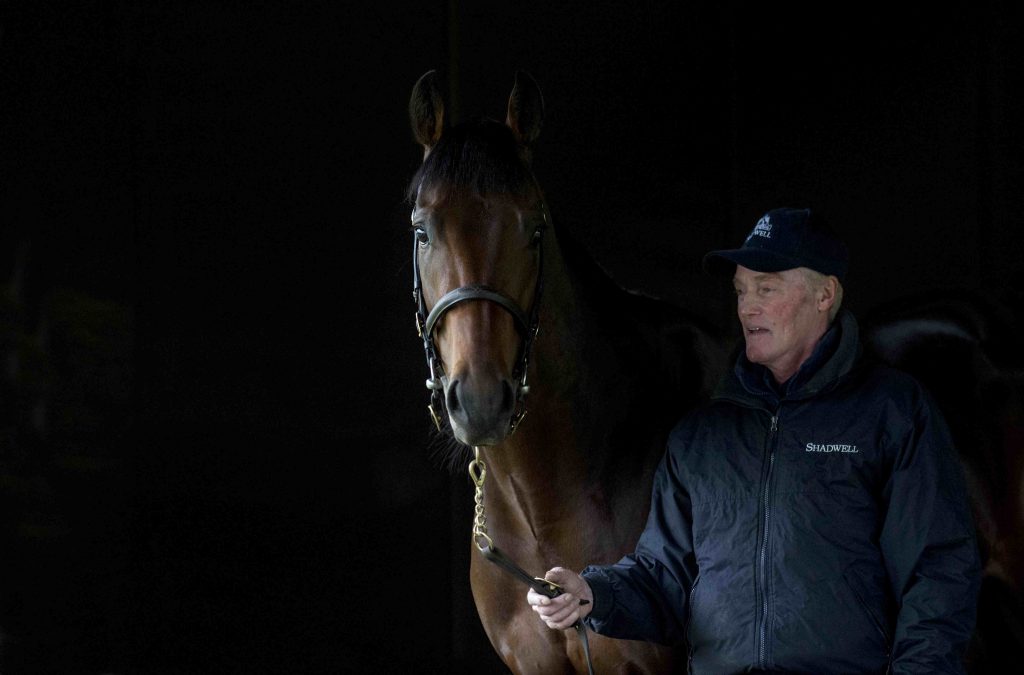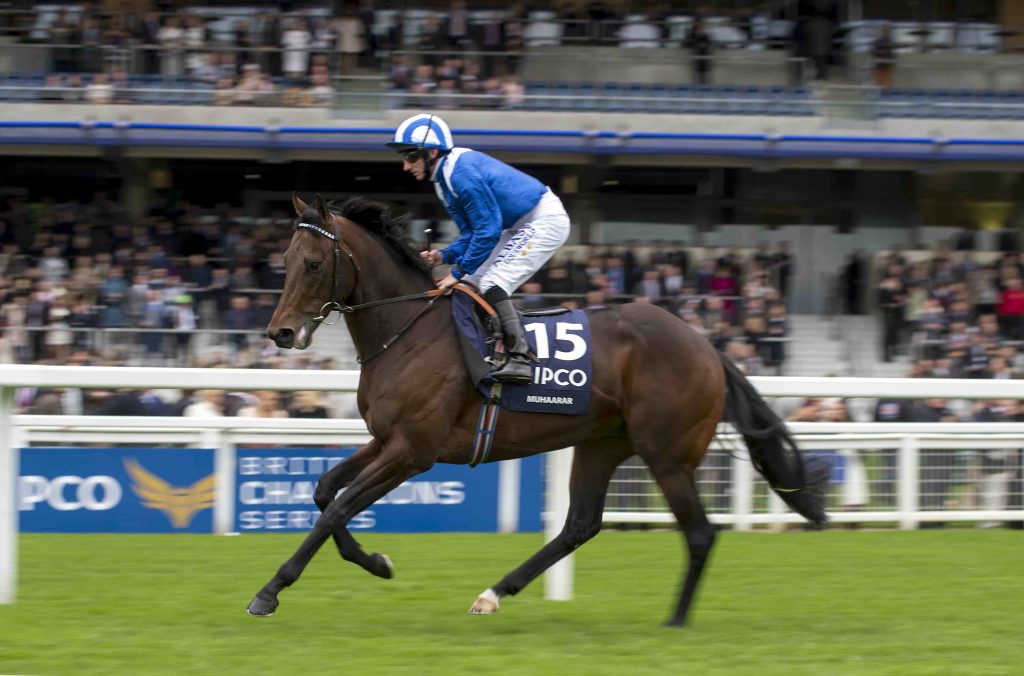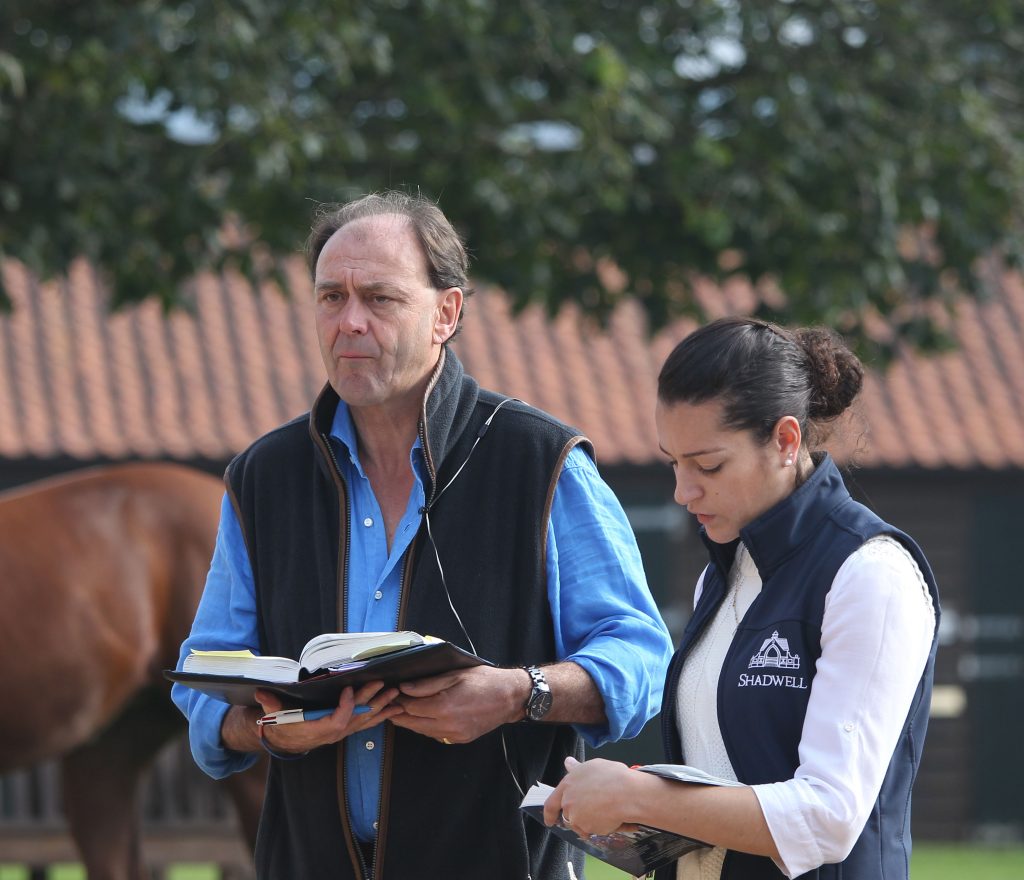When Muhaarar took up residence at Nunnery Stud in October he was the second new stallion to join the roster in 12 months. In one fundamental respect, however, he was the first horse of his type to stand at Sheikh Hamdan Al Maktoum’s breeding establishment for three decades.
Nunnery Stud has long been associated with stallions who established their racing merit over ten and 12 furlongs. The likes of Sakhee perpetuated a trend established by those renowned siblings Nashwan, Unfuwain and Nayef in offering breeders attractive opportunities in the then middle-distance category.
Yet Muhaarar takes the Norfolk nursery back full circle. The first resident stallion to stand under the sheikh’s Shadwell banner was Green Desert, who retired after he was acclaimed as Europe’s champion sprinter in 1986. And while the middle-distance tribe more than held its own, Green Desert went on to wield a far greater influence.
He was represented by 12 individual Group 1 winners in a career of remarkable consistency. More than that, however, his legacy is dominated by three significant stallion sons in Golden Horn’s sire Cape Cross, the Irish National Stud’s stalwart Invincible Spirit, and Oasis Dream, himself the champion sprinter in 2003.
Now comes Muhaarar, who opens his innings at a fee of £30,000 January 1 Special Live Foal terms. Last season’s champion sprinter is a son of Oasis Dream, although staff at Nunnery are fully entitled to describe him as a grandson of Green Desert. The old boy was put down, aged 32, only in September, so Muhaarar’s arrival could not have been better timed.
Muhaarar had all the credentials to have been as good over a mile had he been tried at that distance later in the season
After a campaign which culminated in his dazzling victory in the QIPCO British Champions Sprint Stakes, which represented his fourth Group 1 triumph, Muhaarar is in need of a summer on his back as he walks alongside Nunnery’s long-time head stallion man Ron Lott. Yet there is no mistaking the elasticity of his movement.
“He looks more like a classic miler than a sprinter,” says Shadwell Stud Director Richard Lancaster. “I think he had all the credentials to have been as good over a mile had he been tried at that distance later in the season.”

Shadwell new boy Muhaarar with Senior Stallion Man Ron Lott
His sole attempt was inconclusive. He drew a compromisingly high stall in the Poule d’Essai des Poulains, from where he ran exuberantly and wide before finishing strongly. He came home eighth of 18 runners on his sole defeat in six seasonal starts, yet the “miler” debate is of little relevance. That’s because Shadwell has been searching for a top-class stallion prospect with natural speed for many years now.
“It’s funny how these things go,” Lancaster muses. “There was a sense of frustration that while Green Desert was coming up with all these fast horses, he never left one behind for us. It’s as if destiny has finally played its hand and given us a top-class grandson instead. It really is wonderful for everyone at the farm.”
From Shadwell’s perspective, Muhaarar provides the ideal opportunity for a speed injection to female families that might require it – especially since a significant element within the outfit’s broodmare band has been nurtured to produce classic middle-distance types.
Speed is something that needs to be reintroduced into pedigrees. Having said that, we don’t want to go from one extreme to the other
“Speed is something that needs to be reintroduced into pedigrees,” Lancaster says. “Having said that, we don’t want to go from one extreme to the other. It was straightforward enough when we had Green Desert but when he retired from covering in 2011 we had to find that speed elsewhere.”
The “extremes” caveat reflects Shadwell’s general philosophy when it comes to selecting mates for a broodmare band upwards of 200, which is based in Britain and the US. In recent years Oasis Dream has been a favoured source of speed and the Juddmonte stallion has rewarded Sheikh Hamdan’s faith – although the likes of Arcano, Aqlaam and Naaqoos, each of them Group 1 winners in the blue and white livery, were bought, rather than bred.
“I suppose it was inevitable we would focus on Oasis Dream,” Lancaster says. “Before Muhaarar came along, he was just about the last champion sprinter with an obvious stallion pedigree. And of course, through him we were able to go back to the Green Desert line.”
On a broader note, Muhaarar’s arrival at Nunnery has emphasised to Lancaster how the demand for sprint sires has evolved since Green Desert’s halcyon days. Demand alone has been striking: by mid-November Lancaster had received more than 370 applications for breeding rights – and that was before the horse was shown to the multitude of breeders attending the Tattersalls December Sales.
“We are delighted with the response and can quite happily say he is well oversubscribed,” Lancaster says. “He has all the right credentials to be a commercial success. His dam, by Linamix, also had speed and Muhaarar himself showed natural speed on the racecourse, never more so than on his last start over six furlongs at Ascot, which he won in a handful of strides.
“He is everything commercial breeders want, and the origins of the applications are encouraging,” Lancaster continues. “We have had quite a few from France, which I imagine is down to him having won the Prix Maurice de Gheest in August. That seems to have helped a lot, so all in all we couldn’t be happier.”
Muhaarar’s arrival prompted Shadwell staff, headed by pedigree analyst Carol Palfreyman, to consider the type of mare that might prove best suited to the new recruit. The logical place to start was with Oasis Dream, so Lancaster additionally sought the views of Juddmonte’s own pedigree consultant Andrew Caulfield.

Muhaarar: his competitive fee has seen breeders flock to the son of Oasis Dream
“Andrew’s view was that Oasis Dream works very well with miler-type of mares; Pivotal mares, for instance,” Lancaster says. “And while Oasis Dream has had plenty of opportunity with Sadler’s Wells mares, it hasn’t really worked out.”
Part of that may be down to Sadler’s Wells’s influence as a top-class source of stamina, which brings Lancaster back to the subject of extremes. “I think you have to be very careful about that,” he says.
“Generally, if you send a middle-distance mare to a sprinter, you’re not going to get a classic miler. It rarely tends to work out that way. So when we came to looking at which of our mares to send to Muhaarar, we looked for the sprinter-miler types that hopefully will get him off to a good start. That first season is a vital time, although at the end of the day it is not just about the stallion. The type of mare he covers has a big input.”
Shadwell will send “12 or 13” mares to Muhaarar, which demonstrates sufficient commitment to his cause without adversely impacting on his availability to outside breeders. And since the horse is heavily oversubscribed, Shadwell has applied many of the same parameters in selecting his outside mates as it did in choosing which of its own mares to send him.
Shadwell’s policy of limiting the book sizes bred to its stallions remains in place – although the numbers have been rising slowly. “Muhaarar will end up covering between 110 and 115 mares,” Lancaster says. “That’s a reasonable number for a first-season sire. We don’t want to over-face him, and it still gives him the chance to be competitive in his first season with runners.”
Mukhadram covered 120 mares in his first season, which he coped with very well. There were 30 breeders who didn’t get in, so we gave them first refusal this time round
One spin-off to Muhaarar’s popularity leaves Lancaster braced for the collective disappointment of breeders whose mares fail to get into the stallion’s court. For all Muhaarar’s potential, a deal of his popularity stems from the £30,000 fee Shadwell settled on. Lancaster knew he could have set it higher without suffocating demand, but his recent experience with Mukhadram, who joined the Nunnery roster for 2015, prompted him to take a similar tack.
After an oversubscribed first season, Mukhadram’s second book was all but closed in November due to popular demand.
“He covered 120 mares in his first season, which he coped with very well,” Lancaster reflects. “There were 30 breeders who didn’t get in, so we gave them first refusal this time round and most have taken it up.”
Mukhadram started at another eye-catching fee, in his case £7,000, which Lancaster doesn’t envisage altering for the first three years. “The key was that we pitched him right,” he says. “You have to take the longer view with this [middle-distance] type of horse. He needs impetus over the first three seasons, after which he will have runners and will have to stand up for himself.”
Mukhadram has certainly let down into a fine specimen. Lott says he has never known a young stallion mature so quickly and the horse, standing on limbs of substance, carries his powerful quarters with a lightness at the walk. “I think the way he looks has been a big factor in his popularity,” Lancaster says.
Mukhadram is more in the mould of stallions past at Nunnery. The son of Shamardal posted his signature performance in winning the Eclipse Stakes over a mile and a quarter. And the attractive terms under which he has been managed reflect Shadwell’s past experience of standing middle-distance horses.
“We know that standing a middle-distance horse is quite a difficult thing to do,” Lancaster says. “It has become hard to promote Arc winners when that race is among the jewels of European racing, but from Shadwell’s point of view Mukhadram started something when he arrived last year.
“The stallions were like a football team with ageing stars, so we needed new blood. To run a stallion operation with four or five stallions, you really need a new horse every year. It keeps everybody here at the top of their game, and it exposes the other stallions to a lot of breeders who would not ordinarily have come to the farm.”
When Lancaster came out of the Army in 1984 he went to work for leading US breeder and consignor Lee Eaton. Among the horses Eaton consigned that year was a small son of Danzig who fetched $650,000 at the Keeneland September Yearling Sales. Subsequently named Green Desert, Lancaster was on hand when the colt took his first tentative steps towards his racing career.
Lancaster was also on hand when Green Desert made his name as a leading sire for Shadwell. And he will be on hand once again as Muhaarar endeavours to extend his grandsire’s reputation as a primary influence on the contemporary thoroughbred.
An organic shift in gears at the sales
Ever since Sheikh Hamdan took to British racing in the late 1970s he has always been active at the yearling sales. Shadwell’s appetite for sales-ring action remains unsated to this day.
However, with Shadwell’s broodmare band now mature, there has been a change of emphasis in the type of yearling it is attracted to. Demand for well-bred fillies is now matched by the desire to fill in gaps arising from a breeding policy geared to producing essentially Classic horses between eight and 12 furlongs.
In Shadwell’s case, that means buying in precocious two-year-old types required to win at venues like Royal Ascot – although Shadwell’s Racing Manager Angus Gold says the situation has evolved organically, rather than through any policy statement.
We have never sat down and said we have to buy a more commercial, sprinting type of horse
“We have never sat down and said we have to buy a more commercial, sprinting type of horse,” Gold says. “We mostly breed middle-distance type horses which take a while to come on stream and the boss likes competing in all races, including two-year-old races, even though we have never tried to breed that type of horse.”

Angus Gold: buys for Shadwell at the sales
Interestingly, Sheikh Hamdan’s five most successful horses by win prize-money in Britain last season were sprinters. Four of them – Adaay (by Kodiac), Muthmir (Invincible Spirit), Tasleet (Showcasing) and Waady (Approve) – were bought as yearlings or breeze-up horses. The exception was Muhaarar.
“Muhaarar’s emergence is very exciting for us because he is the type of horse we have lacked,” Gold says. “He was a homebred who turned out to be classy and fast, but, by and large, our operation is a bit different. Also, up to 100 of our yearlings spend the winter in Dubai. By the time they come back to Britain as two-year-olds, acclimatise themselves and get rid of the little bugs they pick up in May, it’s too late for Royal Ascot.”
A feature of the last decade has been that two-year-olds by ‘sprint’ sires have become more competitive in the end-of-season Group tests – Tasleet among them. The appeal of juveniles by the likes of Showcasing, Kodiac and Dark Angel is thus more enticing.
“These sires are proving they can get Group-class horses,” Gold says. “We don’t specifically set out to buy horses by them, they have just created a good impression by the way their progeny are performing.”
That is why, alongside a pair by Sea The Stars bought for 400,000 and 270,000 guineas at the recent Tattersalls December Foal Sales, Gold signed tickets for colts by Dark Angel at 250,000 guineas and Kodiac at 200,000 guineas.



